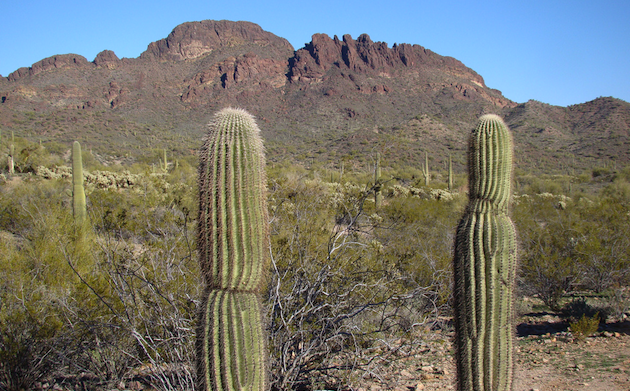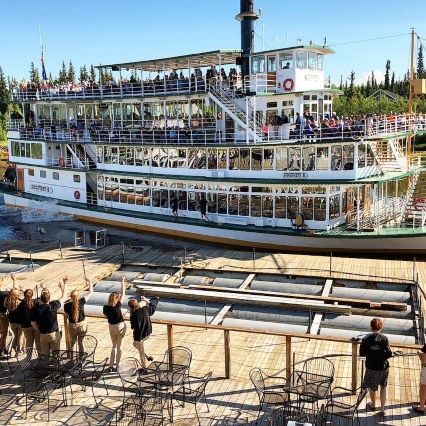Wickenburg is the Old West’s most Western town
Visit the Desert Caballeros Western Museum

Wickenburg, Arizona, is a cowboy town that has been called the Dude Capital of the World or The West’s Most Western Town. The town’s Gold Rush Days Celebration and Rodeo and the Desert Caballeros Trail Ride reflect this western heritage. Guest ranches such as the Rancho de Los Caballeros and the Flying E Ranch attract people who want to experience life in the saddle.
It was, however, mining that gave Wickenburg its start. In 1863, Henry Wickenburg from Austria discovered gold in the Vulture Mountains and before the gold rush was over, $30 million came out of the Vulture Mine. At the same time, 14 miles (21 km) north along the Hassayampa River, the little pueblo of Wickenburg was established largely because of an underground spring of fresh water. That led the present chamber of commerce and town council to erect a sign: No Fishing from the Bridge—with the bridge spanning a dry river bed.
Following the prospectors and miners, farmers and ranchers moved into the fertile Hassayampa River Valley, but conflict soon developed with the Yavapai-Apache or Tolkapaya Indians. By December 1872 General George Crook had defeated the Indians in a decisive battle at Salt River Canyon (the Tonto campaign) and moved them to a reservation near Camp Verde.
Even following the Indian Wars, Wickenburg did not evolve easily. The town suffered from mine closures, drought, outlaws and a disastrous flood in 1890. When the railroad finally arrived in 1895, Wickenburg began a steady growth into a ranching community. This Western small town of 6,500 is located 60 miles northwest of Phoenix on Highway 60 and has some unique attractions.
Top 5 things to see in Wickenburg
- ATSF Railroad. This is the historical railroad depot and is only one of 23 buildings in Wickenburg listed on the National Register of Historic Places. The railroad is the Atchinson, Topeake and Santa Fe 761 steam locomotive that was built in 1890. This train was used on the main line from Chicago west before finding a permanent home in Wickenburg. The railroad depot now serves as the chamber of commerce and visitor centre, with the train located adjacent to the depot. The railroad track behind the depot was built in 1893 and is still used by the modern ATSF Railroad.
- Vulture Gold Mine. History buffs will like the original gold mine and ghost town. Up to 5,000 people lived in this mining town at one time. The buildings have changed little since they were abandoned and sighting of ghosts has been reported. Guides who are professional engineers and geologists and provide a tour of the buildings and machinery. Do not steal any gold, because 18 men were hanged from the Hanging Tree near the center of town. The Vulture Gold Mine is located 12 miles (20 km) south of Wickenburg (turn at Safeway) on the South Vulture Mine Road and is open only on Saturdays.
- Desert Caballeros Western Museum. Located downtown, this is one of the best local museums in the state. The museum has different exhibits, although the history of Wickenburg, Southwest art and a Western theme dominate. The museum has both permanent and current collections from artworks to gems and minerals. There is a good representation of native art and artifacts along with Hopi pottery. The curators have even recreated an Old Town with storefronts and a house from the 1890s. One of their unique exhibits is called Cowgirl Up, or Art from the Other Half of the West, that features female artists. The museum also offers lectures, workshops, art classes and tours.
- Walking tours. There are historical walking tours of the downtown area featuring 31 historical sites and bronze sculptures. A more chilling tour is the Wickenburg Legends and Ghost Tours. This 90-minute guided tour features such stories as Tales of the White Coyote or The Ghost of the Vernetta Hotel. In walking the downtown area, it does not take long to realize Wickenburg has some unique street art. There are six large sculptures with voice narratives of early pioneers telling their stories. In addition, there are painted wall murals and 16 bronze creatures such as rattlesnakes, gila monsters, tarantulas and road runners along the sidewalks. The artist was J. Seward Johnson, known for his realistic works of art. Make sure not to miss the one time Wickenburg jail, a 200-year-old mesquite tree that prisoners were chained to.
- Del E. Webb Center for the Performing Arts. This 600-seat theater is a state-of-the-art facility dedicated to enhancing the cultural and educational richness of Wickenburg and surrounding communities. It was built in 2000 by the Wickenburg Foundation of the Performing Arts, the local school district and the Del E. Webb Foundation. For a small town of 6,500 people, the theatre hosts impressive touring groups, including the Russian National Ballet, the Chinese National Symphony and the Canadian Tenors.
If you are looking for a place to stay, there are several RV Parks in Wickenburg, but there is really only one place to stay. Take the South Vulture Mine Road six miles (11 km) past the Caballeros Golf Course and enjoy the saguaro cacti that guard the road. When you reach the Vulture Peak Trail, boondock in the little valley among the beautiful Vulture Mountains.
In 2013, Wickenburg celebrates its 150th anniversary and looks forward to the next 150 years.






